Fishwick P.A. (editor) Handbook of Dynamic System Modeling
Подождите немного. Документ загружается.

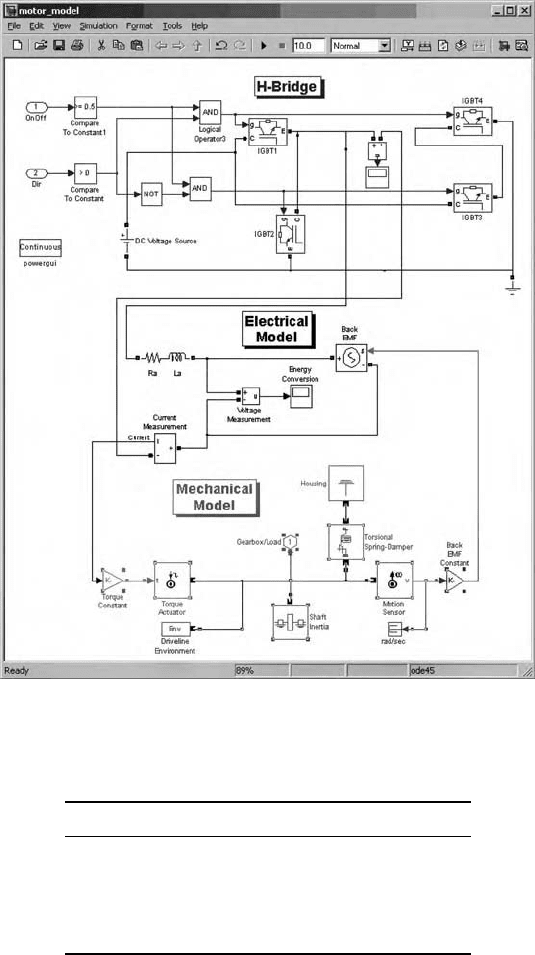
37-10 Handbook of Dynamic System Modeling
FIGURE 37.7 Model of a DC motor and the signal conditioning hardware.
TABLE 37.1 Estimated Parameter Set.
Name Parameter Value Unit
Viscous friction B 0.008 Nms/rad
Shaft inertia J 5.7e
−7
kgm
2
Motor constant Km 0.0134 Vs/rad
Armature inductance La 6.5e
−5
H
Armature resistance Ra 1.9 Ohm
Input/output data from the motors can be applied to tune parameters in the model until the computa-
tional model mimics the behavior of the real robotic arm with sufficient precision. The typical workflow
is as follows:
•
Connect a voltage source to a motor on the robotic arm.
•
Input a voltage to the motor and read the resulting position sensor values, and save these as
input/output datasets.
•
Repeat this with different types of input such as steps, ramps, and frequency sweeps.
•
Select the parameters to tune.
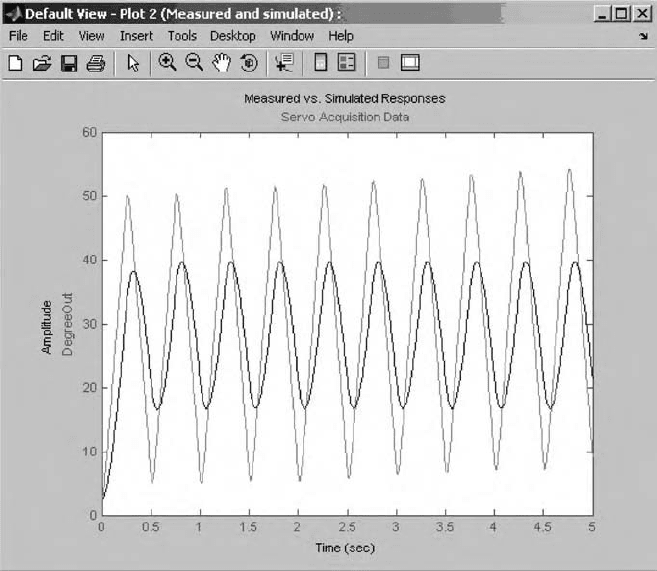
On Simulation of Simulink
®
Models for Model-Based Design 37-11
FIGURE 37.8 Actual response and model response before fine-tuning the parameter estimates.
•
Some datasets will be used to tune the parameters while others can be used to validate the tuned
values.
•
Using the input/output datasets, tune the parameters until the input produces an output that
matches the actual robotic arm with the desired precision.
•
For validation, simulate the model with an input from one or more datasets that were not used for
tuning.
•
Compare the computational output to the output from the validation dataset. If they match within
reasonable tolerances, the model is sufficiently tuned for design.
Figure 37.9 shows the comparison of the outputs from the computational model to the robotic arm
outputs after tuning. Note that the results overlap closely. At this point, the model can be used to design the
controller, for example, by employing classical, modern, and robust control design approaches (Franklin
et al., 2002; MacIejowski, 1989; Ogata, 2001; Skogestad, 1996; Zhou and Doyle, 1997).
37.5.4 Generating the Motor Models from Data
In some cases, modeling the individual components of the overall system in detail may not be of great
interest. Though it is of value when, for example, designing the DC motor configuration, for the design
of the motor controller it may not be critical. In case of designing the controller, the entire motor model
can often be treated as a black box. A linear model of the motor can be estimated using the same datasets
used in Section 37.5.3. This approach works well when the system being modeled is relatively linear like
the motor used here. Using the System Identification Toolbox, a model can be identified using a similar
workflow as shown in Section 37.5.3.
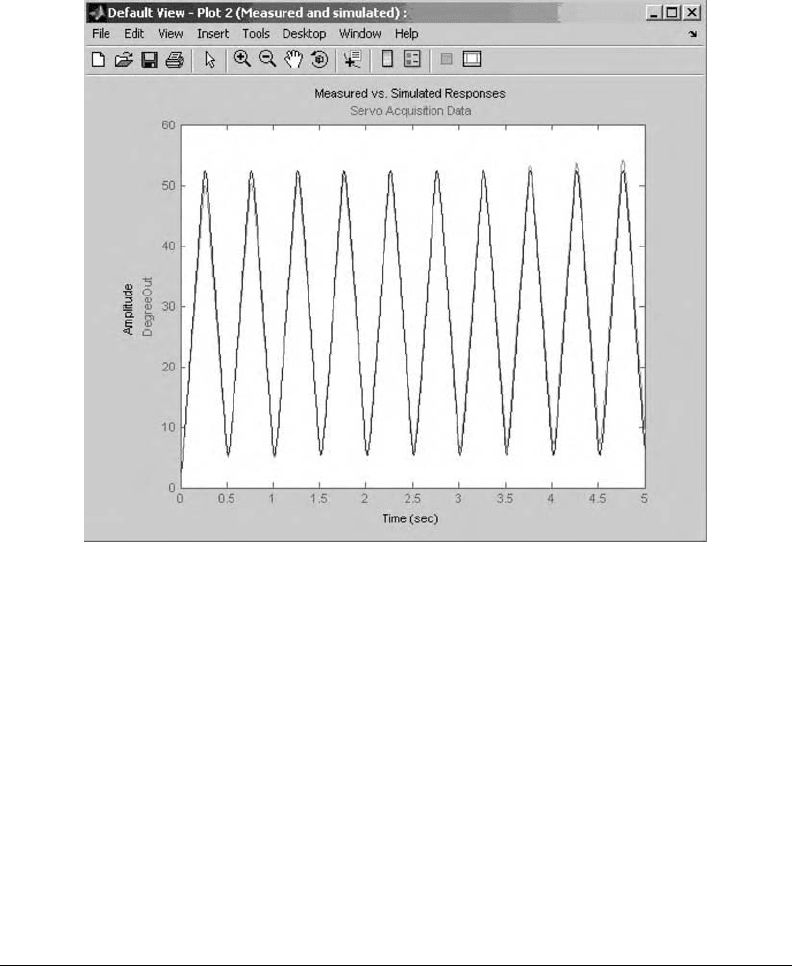
37-12 Handbook of Dynamic System Modeling
FIGURE 37.9 Actual response and model response after fine-tuning the parameter estimates.
•
Connect a voltage source to one motor on the robotic arm.
•
Input a voltage to the motor and read the resulting position sensor values, and save these as
input/output datasets.
•
Repeat this with other inputs such as steps, ramps, and frequency sweeps.
•
Some of the inputs can be used to identify the model while others are used to validate the model.
•
Using the input/output datasets, identify the model until the input produces an output that matches
the robotic arm.
•
For validation, use input from a dataset that was not used for identification.
•
Compare the computational output to the output from the dataset. If they match within required
tolerances, the model is sufficiently accurate for design.
37.6 Using Computational Models for Control Design
The preceding sections have investigated how to obtain accurate dynamic models of physical devices. As
stated earlier, one important reason to develop accurate computational models of physical processes and
devices is to facilitate the design of control laws for regulating or controlling their behavior.
37.6.1 Designing Controllers through Modeling and Simulation
The most basic approach to designing a control system need not rely on computational models, but rather
can be developed through paper and pencil analysis, design, and iteration on the real systems that will be
controlled. This approach normally requires a lot of experience, and is typically complex to implement.
Additionally, it is more costly to implement because of the resources needed to mitigate the risks of

On Simulation of Simulink
®
Models for Model-Based Design 37-13
damaging the system and actually making the physical system available for design work. Some benefits of
using computational models and simulation to design controllers are
•
Ability to use specialized simulation-based control algorithm development tools.
•
Ability to evaluate hardware and system constraints such as actuator effort and response time in a
safe, low-cost environment.
•
Increased innovation through the ability to experiment with many possible solutions before
implementation.
The actual process to design controllers in a modeling and simulation environment varies depending
on the tools available. This section describes the approach used to design controllers in a simulation
environment and also studies the use of some specialized tools that aim to simplify the design process. The
typical process, which will be described in detail in the subsequent subsections, is
•
Model the dynamics of the device or process being controlled (see Section 37.5 for the modeling of
the robotic arm).
•
Obtain a linear representation of this “plant” model about the relevant operating points.
•
Use linear control design techniques to tune the controllers to meet performance requirements.
•
Validate the linear control design on the nonlinear computational model.
An alternative to this process is to use tools that depend on simulation and optimization-based tech-
niques. For the design of a controller for the robotic arm, a set of tools called Simulink Control Design
(2006), Control System Toolbox (2006), and Simulink Response Optimization (2006) are used. A single
workflow-based graphical user interface (GUI) serves as a task manager and portal to this set of tools.
In the case of the robotic arm, the control task is to move the hand to a desired point in space. This is
done by manipulating the arm segments of the robot arm. The exact control design goals are as follows:
2
•
Robot arm position control:
— Design joint angle controllers for the turntable, bicep, forearm, and hand joints.
— Design prefilters to balance the bandwidths of the responses to reduce the impact of off-
diagonal closed-loop responses.
•
Joint angle loop control requirements:
— The bandwidth is less than 50 Hz.
— The gain margin is greater than 20 db.
•
Closed-loop position control step-response requirements:
— The overshoot is less than 10%.
— The rise time is less than 1.5 s.
— The cross-coupling is less than 10%.
The model developed in the previous sections is used as a starting point. It will need to be linearized to
investigate how controllers can be designed to meet the specified requirements.
37.6.2 Linearizing Models for Control System Design
With the robotic arm, the first step is to obtain a linear representation of the nonlinear model. The
linearized model is then used to compute pertinent open- and closed-loop response plots that are used
directly in control design. To obtain the linearized model, the following steps need to be taken:
•
Specify the control structure in Simulink, with feedback loops, compensators, and prefilters as
shown in Figure 37.10.
2
Detailed definitions and descriptions of these terms can be found in the online documentation of the Control
System Toolbox (2006), http://www.mathworks.com.

37-14 Handbook of Dynamic System Modeling
Measured
angles
Feedback
controllers
Plant
Measured
angles
Motor
voltages
Actual X, Y, Z
Desired
angles
F
i
(s)
x
y
z
Prefilters
Desired positions
Coordinate
transformation
f(x, y, z)
t
s t
F
3
F
4
F
2
F
1
PI
1
PI
2
PI
3
PI
4
FIGURE 37.10 Feedback loop structure.
•
Select the eight compensatorsto be tuned which include four prefilters and four feedback controllers.
•
Select the closed-loop inputs and outputs which map the desired position to the actual measured
position.
•
Specify or compute the operating points for the linear analysis of the model.
Linear models are then automatically extracted using the information from these steps. These linear
models are used to setup the control design task in the GUI.
The open- and closed-loop linearization results are highly dependent on the operating point—for exam-
ple, the states of the integrators of the model at different operating points. Trim or equilibrium operating
points are a special type of operating point that engineers find very useful. A basic description of equilib-
rium conditions is that, over time, the operating point remains steady and constant. In Simulink and other
block diagram simulation tools there are two commonly used approaches to specify equilibrium condi-
tions of a model of the physical system. The first method is that the users employ their intuitive knowledge
about the system to pick an equilibrium condition. This can be a rather time-consuming and difficult
process because of the large number of operating points that must be specified in a complicated model.
The second option is to employ an approach known as trim analysis. The approach uses optimization
to solve for a set of operating points that satisfy the equilibrium conditions. Simulink Control Design pro-
vides trim analysis capabilities to obtain initial conditions for various operating points. Another alternative
is to use “simulation snapshots” to specify operating points close to the region where the control effort is
desired.
In the case of the robotic arm, the model was linearized at a number of operating points for different
positions of the arm. A single operating point was selected for the design and the other operating points
were used to verify the control system of the robot arm in different configurations.
37.6.3 Designing a Controller
Once a linearized open-loop model has been obtained, a typical next step is to select a control system
structure and tune the individual compensators. In the case of designing a controller for the robotic arm,
the control structure is specified in the earlier step to help the tool determine the linear representation.
The robotic arm controller configuration consists of four feedback loops with prefilters as shown in
Figure 37.10. For such a multiloop system, several input/output combinations have to be linearized to
attempt to design multiple controllers such that the overall multiloop system meets controller performance
requirements. Multiloop controller design can be approached in a number of ways:
•
Sequential loop closure where the designer first tunes one loop with the others open, and then
sequentially closes the other loops.
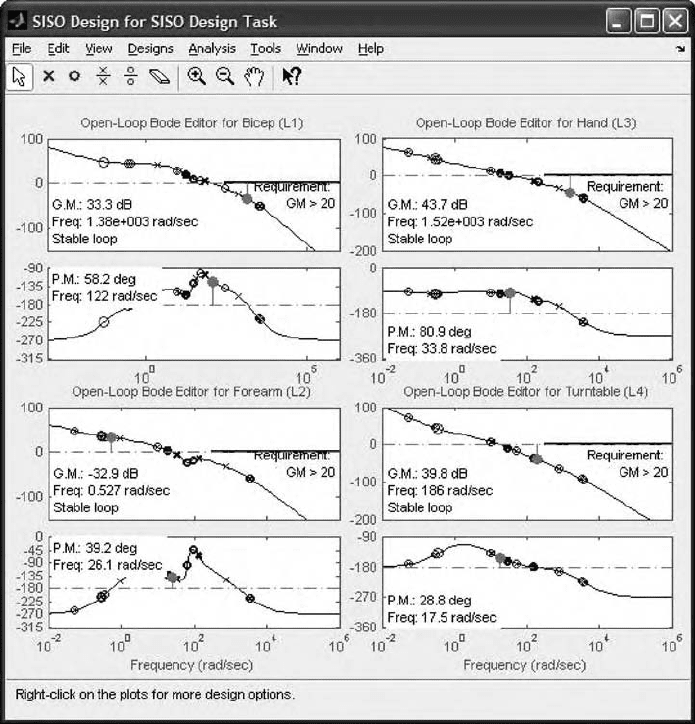
On Simulation of Simulink
®
Models for Model-Based Design 37-15
FIGURE 37.11 SISO design plots.
•
Use traditional MIMO design techniques such as H-infinity to tune the loops simultaneously.
•
Simultaneously tune the coupled single input single output (SISO) control loops.
For the robotic arm, the GUI is used with the linearized model to setup a control design task to design
the controllers. The steps are
•
Select design plots such as root locus, Bode and Nichols charts for each loop that needs to be
designed.
•
Select closed-loop analysis plots for viewing.
•
Use design plots (Figure 37.11) to graphically shape all loops and edit the compensator structure,
while viewing loop interactions and closed-loop responses in real time.
Because the tools can compute loop interactions while tuning all loops, the approach is to use visu-
alization to see how changing one compensator affects all the other responses that are of interest. The
graphical design tools can be employed in this way to design a set of compensators to try to best meet
the performance requirements. Additionally, optimization techniques within these graphical tools can be
exploited to help tune existing controllers, while trading off between multiple design requirements.

37-16 Handbook of Dynamic System Modeling
FIGURE 37.12 Closed-loop responses before (left) and after (right) optimization.
37.6.4 Tuning Controller Designs Using Optimization Techniques
The described graphical design tools simplify tuning an MIMO controller by enabling simultaneous tun-
ing of loops. However, the process can still be quite complex; especially for systems with many tightly
coupled loops. Because a computational model is available, this process can be simplified by leveraging
optimization techniques to automate multiloop tuning. Using Simulink Response Optimization, perfor-
mance bounds and requirements can be specified on the design and closed-loop response plots and then
several compensators can be tuned simultaneously through optimization. This is done by graphically
specifying requirements in either the time domain, as overshoot, settling time, etc. or in the frequency
domain, for example, as gain/phase margin, bandwidth, or pole zero locations.
For the robotic arm, the performance requirements listed above are specified for the controller by
using a combination of both time-domain and frequency-domain plots. The optimization is then run
to obtain a valid solution. Figure 37.12 shows the final responses obtained and how these fit within the
performance envelopes that are defined. Note that although the system being tuned is an MIMO system,
the problem is configured as eight coupled SISO controllers that are tuned simultaneously. In the event that
the optimization is not able to meet all requirements, the requirements can be relaxed, or, alternatively, a
different control strategy can be evaluated using all the methods that have been discussed. Once satisfactory
control performance is obtained, the design can be validated on a full nonlinear simulation by exporting
the controller gains directly to the Simulink model.
37.7 Testing with Model-Based Design
One aspect of Model-Based Design is the testing of designs while they are under development. By testing
early in the design phase, errors and deficiencies may be recognized and rectified early in the design phase,
before the cost of correction becomes too high, or worse, the error makes it into the final implementation.
Testing early and often is a good principle, and it is imperative to do so in a systematic manner.
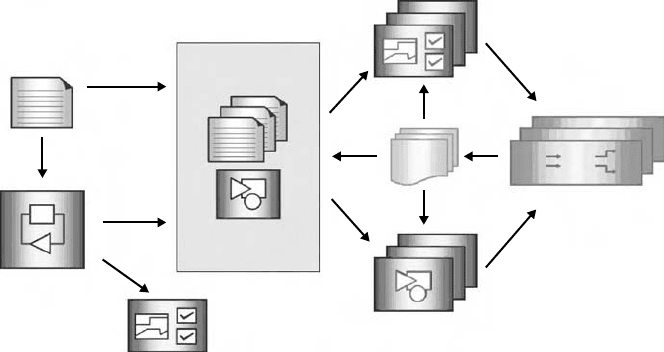
On Simulation of Simulink
®
Models for Model-Based Design 37-17
System
requirements
Component
test harnesses
Coverage
report
Component
designs
Component
requirements
Integrated
test harnesses
with designs
Closed-loop
system model
System test harness
System
architecture
FIGURE 37.13 An overview of Model-Based Design.
37.7.1 Requirements-Based Testing through Simulation
Requirements-based testing, which can contribute to systematic testing, refers to defining test vectors for
each requirement, and creating corresponding checks to verify that the requirements are met. Essentially, a
test harness is created to verify that the design algorithm meets the requirements. This workflow is shown
in Figure 37.13.
The test vectors typically consist of a series of inputs designed to exercise the computational model
through a range of expected and unexpected behavior. In case of the latter, this enables testing of dangerous
modes of operation, and the corresponding design of fail-safe elements. Often this kind of failure-mode
testing in simulation is impossible to do with a physical prototype or implementation of the system. In
addition to test vectors, verification blocks in Simulink can be used to check model output data ranges
and ensure that requirements are met. Once a test harness with test vectors and verification blocks has
been obtained, a coverage report can be generated to understand how well the algorithm was exercised.
Using Simulink Verification and Validation (2006), coverage metrics are collected as the tests execute to
quantify which elements of the design have been excited and which have not. Using coverage-based test
verification, the following features and benefits are achieved:
•
Measure how well the model has been exercised.
•
Identify what additional test vectors are needed to exercise the model more thoroughly.
•
Identify and remove unnecessary elements in the design.
•
Ensure that the requirements, design, and tests are consistent and complete.
37.7.2 Simulation with Hardware and Implemented Designs
In addition to the use of computational models for simulation during the design stages, models can also
be used in real-time simulations for verification and validation. In such a scenario, computer code is
generated from the computational model and downloaded to dedicated computers to simulate the model
in real time. This is often referred to as rapid prototyping, of which there are two variations. The first is
rapid controller prototyping, which typically involves placing the controller algorithm on a processor such
37-18 Handbook of Dynamic System Modeling
as a commercially available PC-based processor, and interfacing the processor with the plant, here the
robotic arm. The entire system is then simulated in real time (Mosterman et al., 2005).
The second variation is hardware-in-the-loop (HIL), which refers to interfacing the processor on which
the controller runs with a combination of real hardware and computational models, and running in real
time on dedicated processors. HIL enables the integration of difficult-to-model hardware as part of the
simulation environment. For example, actuators can be highly nonlinear, and so if a model of such an
actuator is used, the analysis may not be sufficiently precise. HIL allows the model of the physical system
minus the actuator to be connected to the real actuator and hence enables the full nonlinear behavior to
be validated.
In the case of the robotic arm, rapid controller prototyping is used with xPC Target (2004). Code is
generated from the controller algorithm using Real-Time Workshop
®
(2002). Next, using a commercially
available PC running the real-time kernel of xPC Target, the controller algorithm is downloaded onto the
PC and commercially available I/O boards are used to connect the PC to the robotic arm. The control
algorithm running on the PC is then used to control the robotic arm and validate the algorithms. At this
point, the controller algorithm can be tuned in real time, while connected to the robotic arm. Alternatively,
the algorithm can be modified and code regenerated to test the new algorithm. This process is repeated till
the algorithm operates satisfactorily.
Reasons to perform rapid controller prototyping include
•
Quick algorithm testing and retesting using hardware that has been tested in simulation.
•
Testing control algorithms with fixed-step solvers in real time, which is closer to real-world
implementations.
To briefly study an example of HIL, consider a flight-control application with the flight controller
implemented on the actual flight-control box, a dedicated computer that will go into the production
aircraft. The flight-control box could then be integrated with a cockpit, a human pilot, and a flight-
simulator package. The cockpit would enable the pilot to provide realistic inputs, while the flight simulator
could be running the aircraft dynamics computational model (that havebeen modeled using a combination
of the three modeling methods) to validate the behavior of the controller.
The flight simulator could be mounted on a motion-simulator platform to generate the appropriate
forces and torques. Models of wind and turbulence and atmospheric effects can be included to test the
behavior of the controller in “dangerous” situations without risk to the pilot or the aircraft. This can
be implemented through the use of xPC Target and models generated with Simulink and the physical
modeling products such as SimMechanics. This approach is very useful in safety-critical applications
such as those found in aircraft and other vehicles, where testing with the real hardware is expensive,
time-consuming, and often heavily regulated.
37.7.3 Other Uses of Rapid Prototyping in the Design Process
To design a control system, rapid prototyping tools can be used as shown in Figure 37.14 for other stages
of the process including the actual computational modeling. At the start of the control design process, an
engineer may have a rather inaccurate model or no model at all. So, at first a skeleton control system is
developed to stabilize a system and to get the desired behavior to experiment with. Once this is achieved,
experiments can be designed and performed to acquire responses of the system at various operating
conditions. The acquired data can then be exploited to enhance the plant model, and to design a new
control system using the more accurate plant model. Simulation of the combined control system and
plant model then allows studying the performance of the system and the control system can be optimized
using the full nonlinear plant simulation model. Finally, the control system can be implemented on a
rapid prototyping system. If the system does not meet the performance of the control system as obtained
in simulation, the model is further refined as well as the design of the control system to try to achieve
improved performance.
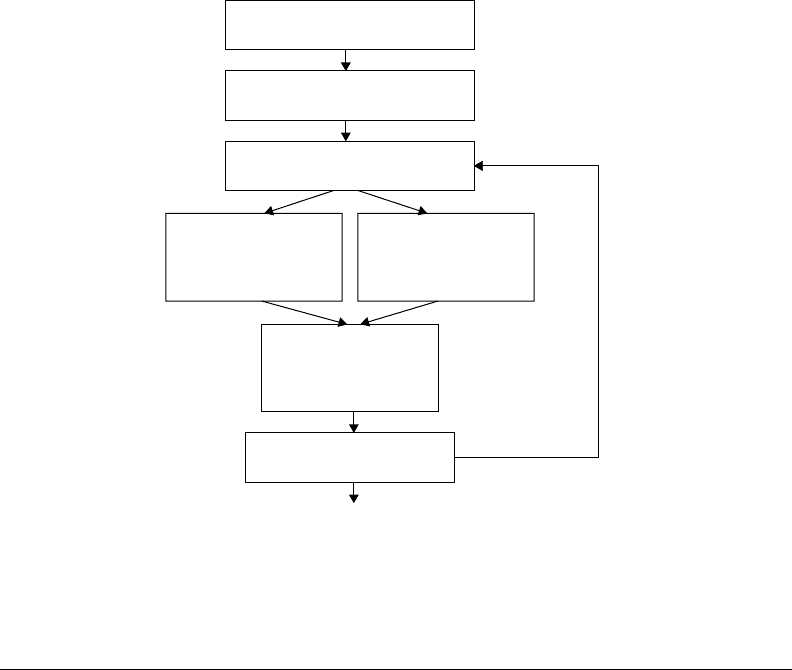
On Simulation of Simulink
®
Models for Model-Based Design 37-19
Develop skeleton control
system for the experiment
Perform experiments for data
acquisition for system modeling
Enhance simulink plant model
with data
Design dynamic
feedback controllers
on a linear plant
model
Design other control
system elements
using the nonlinear
plant model
Optimize the control
design on the
nonlinear plant
model
Implement on the rapid
prototyping station
Needs enhancement?
Done
FIGURE 37.14 Rapid prototyping control design process.
37.8 Conclusions
Through the use of advanced computational modeling and numerical simulation capabilities available
in Simulink, an accurate model of the robotic arm can be quickly obtained and fine-tuned with mea-
sured data. Control algorithms for the robot arm were then designed and tested rapidly and effectively.
Using requirements-based testing and rapid controller prototyping each requirement was systematically
tested and the entire set of requirements was formally verified. When the control algorithm was finally
implemented its proper behavior to control the actual robotic arm was established with confidence. It was
thoroughly analyzed to deliver the required performance, even under fault conditions.
MATLAB, Simulink, Stateflow, Handle Graphics, Real-Time Workshop, and xPC TargetBox are regis-
tered trademarks and SimBiology, SimEvents, and SimHydraulics are trademarks of The MathWorks Inc.
Other product or brand names are trademarks or registered trademarks of their respective holders.
References
R. Aberg and S. Gage. Strategy for successful enterprise-wide modeling and simulation with COTS soft-
ware. In AIAA Modeling and Simulation Technologies Conference and Exhibit. Providence, Rhode
Island, August 2004. CD-ROM.
K.J. Åström and B. Wittenmark. Computer Controlled Systems: Theory and Design. Prentice-Hall,
Englewood Cliffs, NJ, 1984.
P. Barnard. Graphical techniques for aircraft dynamic model development. In AIAA Modeling and
Simulation Technologies Conference and Exhibit. Providence, Rhode Island, August 2004. CD-ROM.
J.S. Bendat and A.G. Piersol. Random Data: Analysis & Measurement Procedures. Wiley-InterScience,
Hoboken, NJ, 2000.
